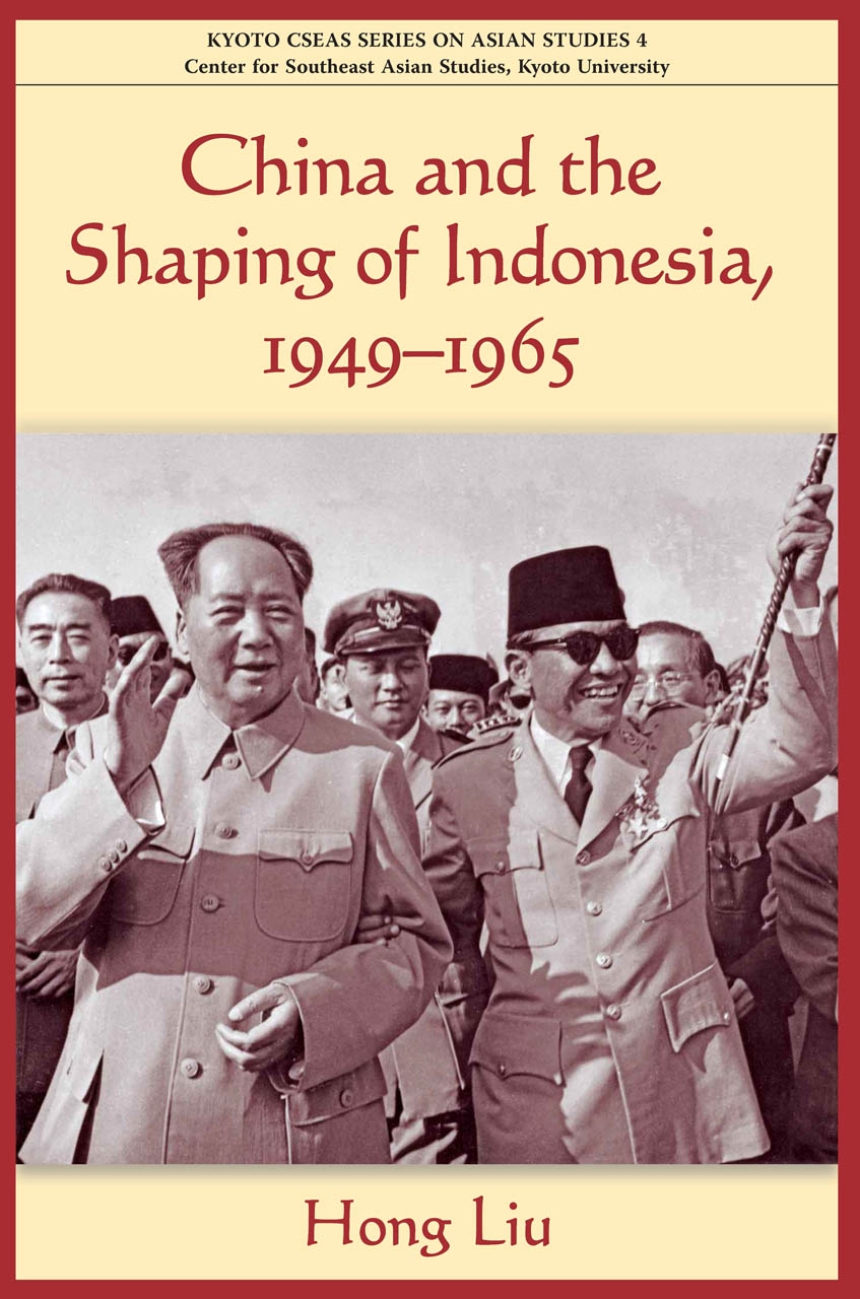Distributed for National University of Singapore Press
China and the Shaping of Indonesia
The interactions and mutual perceptions of China and Indonesia were a significant element in Asia's postcolonial transformation, but as a result of prevailing emphasis on diplomatic and political relations within a Cold War and nation-state framework, their multi-dimensional interrelationship and its complex domestic ramifications have escaped scholarly scrutiny.
China and the Shaping of Indonesia provides a meticulous account of versatile interplay between knowledge, power, ethnicity, and diplomacy in the context of Sino-Indonesian interactions between 1949 and 1965. Taking a transnational approach that views Asia as a flexible geographical and political construct, this book addresses three central questions. First, what images of China were prevalent in Indonesia, and how were narratives about China construed and reconstructed? Second, why did the China Metaphor - the projection of an imagined foreign land onto the local intellectual and political milieu - become central to Indonesians' conception of themselves and a cause for self criticism and rediscovery? Third, how was the China Metaphor incorporated into Indonesia's domestic politics and culture, and how did it affect the postcolonial transformation, the fate of the ethnic Chinese minority, and Sino-Indonesian diplomacy?
Employing a wide range of hitherto untapped primary materials in Indonesian and Chinese as well as his own interviews, Hong Liu presents a compelling argument that many influential politicians and intellectuals, among them Sukarno, Hatta, and Pramoedya, utilized China as an alternative model of modernity in conceiving and developing projects of social engineering, cultural regeneration and political restructuring that helped shape the trajectory of modern Indonesia. The multiplicity of China thus constituted a site of political contestations and intellectual imaginations. The study is a major contribution both to the intellectual and political history of Indonesia and to the reconceptualization of Asian studies; it also serves as a timely reminder of the importance of historicizing China's rising soft power in a transnational Asia.
China and the Shaping of Indonesia provides a meticulous account of versatile interplay between knowledge, power, ethnicity, and diplomacy in the context of Sino-Indonesian interactions between 1949 and 1965. Taking a transnational approach that views Asia as a flexible geographical and political construct, this book addresses three central questions. First, what images of China were prevalent in Indonesia, and how were narratives about China construed and reconstructed? Second, why did the China Metaphor - the projection of an imagined foreign land onto the local intellectual and political milieu - become central to Indonesians' conception of themselves and a cause for self criticism and rediscovery? Third, how was the China Metaphor incorporated into Indonesia's domestic politics and culture, and how did it affect the postcolonial transformation, the fate of the ethnic Chinese minority, and Sino-Indonesian diplomacy?
Employing a wide range of hitherto untapped primary materials in Indonesian and Chinese as well as his own interviews, Hong Liu presents a compelling argument that many influential politicians and intellectuals, among them Sukarno, Hatta, and Pramoedya, utilized China as an alternative model of modernity in conceiving and developing projects of social engineering, cultural regeneration and political restructuring that helped shape the trajectory of modern Indonesia. The multiplicity of China thus constituted a site of political contestations and intellectual imaginations. The study is a major contribution both to the intellectual and political history of Indonesia and to the reconceptualization of Asian studies; it also serves as a timely reminder of the importance of historicizing China's rising soft power in a transnational Asia.
366 pages | 6 x 9 | © 2011
Asian Studies: East Asia, Southeast Asia and Australia
Political Science: Diplomacy, Foreign Policy, and International Relations
Table of Contents
Acknowledgements
List of Figures
Introduction: China in Indonesia: What’s in a Name?
Déjà Vu All Over Again? “The China Fever” and Its Significant Precedent
Approaches to China in Indonesia
Nature and Characteristics of China Observers in Indonesia
Structure of the Book
Part I: (Re)presenting China
Chapter 1: Changing Images of China in Pre-1949 Indonesia
Historical Interactions and Perceptions of China in Pre-20th-century Indonesia
Indonesian Nationalists and China, 1900-49
Perceived Parallelisms
Conclusion
Chapter 2: Discourses on Chinese Politics
“New Democracy”: Chinese Practices and Indonesian Perceptions
China in the International Arena: “An Awakening Lion” or “A Threatening Red Dragon”?
“Brother Mao”: Images of Mao Zedong in Indonesia
Conclusion
Chapter 3: Social Dynamism and Economic Progress
The Purposefulness and Orderliness of an Egalitarian Society
New China’s “Amazing” Economic Growth
The People’s Commune as an Epitome of Social and Economic Progress
Making Sense of China’s Socio-economic Progress: Politics or Chineseness?
Conclusion
Chapter 4: Of Culture, Religion and Intellectuals
“New Culture” and Nation-building
Intellectuals in the PRC: “Engineers of Human Souls” or “Tools of Propaganda”?
A Question of Religious Freedom
Conclusion
Part II: Constructing the China Metaphor
Chapter 5: Indonesian Dreams and the “Chinese Realities”: The Sociopolitical and Intellectual Dimensions
Political Instability and Cultural Antagonisms at Home
Disillusionment and Alienation of Intellectuals
Preconceptions about Indonesia and the Construction of China-images
Conclusion
Chapter 6: An “Inner China” and External PRC: The Ethnic and Diplomatic Dimensions
Indonesian Chinese Society and the Construction of Images of the Ancestral Homeland
Brothers of Different Kinds: Indonesians’ Paradoxical Views of the Chinese
Sino-Indonesian Diplomatic Relations and the Making of the China Metapohr
China Creates Its Own Images
Conclusion
Part III: Shaping a New Trajectory
Chapter 7: Sukarno, the China Metaphor and Political Populism Sukarno and China before 1956
Mr Sukarno Goes to Beijing
Sukarno’s Perception of China and Vision for Indonesia
Conclusion
Chapter 8: Pramoedya, the China Metaphor and Cultural Radicalism
Pramoedya before 1956: The Evolution of a Cultural Intellectual
Pramoedya in China: The Politics of a Transnational Romance
The Transformation of Pramoedya: The Critical Years, 1956-59
Conclusion
Conclusion: China as an Alternative Modernity
Appendix: Biographical Notes on Major China Observers in Indonesia, 1949-65
Bibliography
Index
List of Figures
Introduction: China in Indonesia: What’s in a Name?
Déjà Vu All Over Again? “The China Fever” and Its Significant Precedent
Approaches to China in Indonesia
Nature and Characteristics of China Observers in Indonesia
Structure of the Book
Part I: (Re)presenting China
Chapter 1: Changing Images of China in Pre-1949 Indonesia
Historical Interactions and Perceptions of China in Pre-20th-century Indonesia
Indonesian Nationalists and China, 1900-49
Perceived Parallelisms
Conclusion
Chapter 2: Discourses on Chinese Politics
“New Democracy”: Chinese Practices and Indonesian Perceptions
China in the International Arena: “An Awakening Lion” or “A Threatening Red Dragon”?
“Brother Mao”: Images of Mao Zedong in Indonesia
Conclusion
Chapter 3: Social Dynamism and Economic Progress
The Purposefulness and Orderliness of an Egalitarian Society
New China’s “Amazing” Economic Growth
The People’s Commune as an Epitome of Social and Economic Progress
Making Sense of China’s Socio-economic Progress: Politics or Chineseness?
Conclusion
Chapter 4: Of Culture, Religion and Intellectuals
“New Culture” and Nation-building
Intellectuals in the PRC: “Engineers of Human Souls” or “Tools of Propaganda”?
A Question of Religious Freedom
Conclusion
Part II: Constructing the China Metaphor
Chapter 5: Indonesian Dreams and the “Chinese Realities”: The Sociopolitical and Intellectual Dimensions
Political Instability and Cultural Antagonisms at Home
Disillusionment and Alienation of Intellectuals
Preconceptions about Indonesia and the Construction of China-images
Conclusion
Chapter 6: An “Inner China” and External PRC: The Ethnic and Diplomatic Dimensions
Indonesian Chinese Society and the Construction of Images of the Ancestral Homeland
Brothers of Different Kinds: Indonesians’ Paradoxical Views of the Chinese
Sino-Indonesian Diplomatic Relations and the Making of the China Metapohr
China Creates Its Own Images
Conclusion
Part III: Shaping a New Trajectory
Chapter 7: Sukarno, the China Metaphor and Political Populism Sukarno and China before 1956
Mr Sukarno Goes to Beijing
Sukarno’s Perception of China and Vision for Indonesia
Conclusion
Chapter 8: Pramoedya, the China Metaphor and Cultural Radicalism
Pramoedya before 1956: The Evolution of a Cultural Intellectual
Pramoedya in China: The Politics of a Transnational Romance
The Transformation of Pramoedya: The Critical Years, 1956-59
Conclusion
Conclusion: China as an Alternative Modernity
Appendix: Biographical Notes on Major China Observers in Indonesia, 1949-65
Bibliography
Index

